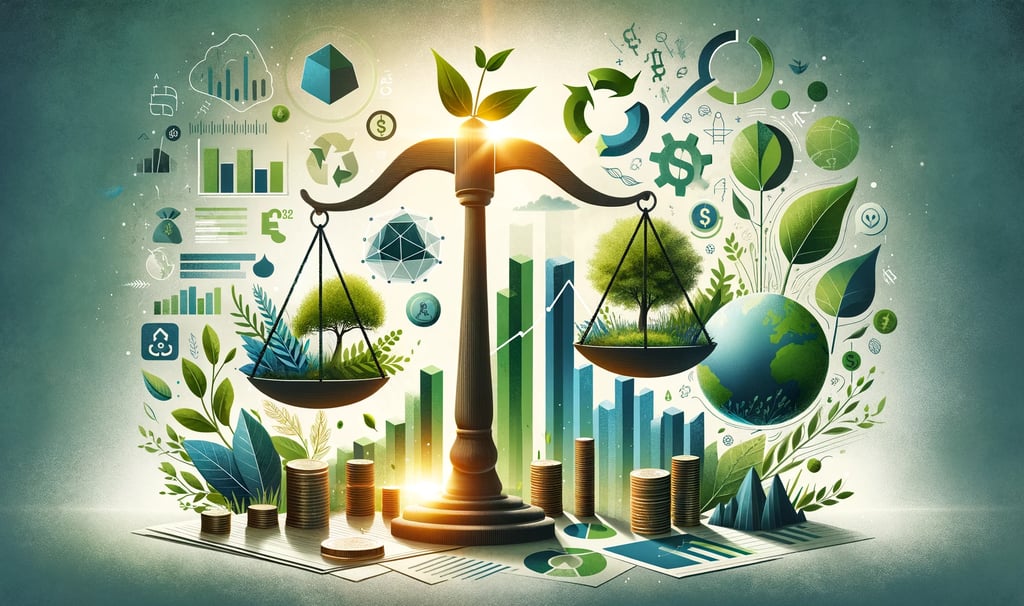Sustainable Procurement Strategies
What is sustainable procurement? This guide explains the three pillars (environmental, social, economic), the benefits, and a 5-step strategy for implementation.
SUPPLY CHAIN
The Procure 4 Marketing Team
12/28/20233 min read


Quick Answer: What is sustainable procurement?
Sustainable procurement is a strategy where organizations consider the environmental, social, and economic (the "three pillars") impacts when buying goods and services. It goes beyond just price and quality to include factors like reducing carbon footprint, ensuring fair labor practices, and supporting local economies. Implementing a sustainable procurement policy involves setting clear goals, evaluating suppliers on sustainability criteria, collaborating with partners, and measuring the impact of these responsible sourcing decisions.
What is Sustainable Procurement?
Sustainable procurement means making purchasing decisions that meet your organization's needs while also minimizing negative impacts (and maximizing positive impacts) on the planet and its people. It's a holistic approach that integrates three key pillars into the traditional procurement process:
Environmental: Reducing waste, conserving natural resources, minimizing pollution, and lowering carbon emissions throughout the supply chain.
Social: Ensuring fair labor practices, promoting diversity and inclusion among suppliers, respecting human rights, and supporting local communities.
Economic: Considering the long-term economic implications, including the Total Cost of Ownership (TCO), supporting small or diverse businesses, and contributing to economic development.
Why is Sustainable Procurement a Strategic Imperative?
Adopting sustainable procurement is no longer just a "nice-to-have" corporate social responsibility (CSR) initiative; it's a core business strategy with significant benefits.
Enhances Brand Reputation & Trust: Consumers increasingly prefer brands that demonstrate genuine commitment to environmental and social responsibility. Sustainable sourcing builds trust and a positive brand image.
Reduces Long-Term Costs: While some sustainable options might have higher upfront costs, they often lead to long-term savings through greater energy efficiency, reduced waste disposal fees, and longer product lifecycles (lower TCO).
Mitigates Supply Chain Risks: Relying on suppliers with poor environmental or labor practices creates significant reputational and operational risks. Sustainable procurement proactively manages these risks.
Ensures Regulatory Compliance: Environmental and social regulations are becoming stricter globally. A sustainable procurement strategy helps ensure compliance and avoids potential fines.
Attracts & Retains Talent: Employees want to work for companies whose values align with their own. A commitment to sustainability can be a powerful tool for attracting and retaining top talent.
Drives Innovation: Partnering with sustainable suppliers often leads to discovering innovative new materials, processes, and technologies that can provide a competitive edge.
How to Implement a Sustainable Procurement Strategy (5 Key Steps)
Step 1: Develop a Sustainable Procurement Policy
Start by creating a formal policy that clearly defines your organization's sustainability objectives and how they apply to procurement.
Actionable Tip: Align your policy with your overall corporate sustainability goals. Set specific, measurable targets (e.g., "Source 50% of packaging from recycled materials by 2028").
Step 2: Integrate Sustainability into Supplier Selection
Update your supplier evaluation criteria to include sustainability metrics alongside traditional factors like cost and quality.
Actionable Tip: Add questions about environmental certifications (like ISO 14001), fair labor practices (audits like SA8000), and diversity status to your supplier questionnaires and scorecards.
Step 3: Collaborate with Suppliers
Work with your suppliers to help them improve their sustainability performance. This is often more effective than simply switching suppliers.
Actionable Tip: Share your sustainability goals openly with key suppliers. Offer training or resources, and explore joint projects to reduce waste or emissions together. Provide incentives for suppliers who meet or exceed your sustainability targets.
Step 4: Prioritize Eco-Friendly Products & Lifecycle Analysis
Actively seek out and give preference to products and services with a lower environmental impact.
Actionable Tip: Implement a lifecycle analysis approach – evaluate the environmental impact of a product from raw material extraction through manufacturing, use, and disposal – to make more informed choices. Prioritize products that are energy-efficient, made from recycled or renewable materials, and designed for durability or recyclability.
Step 5: Overcome Common Barriers
Be prepared for challenges like potentially higher initial costs or limited availability of sustainable options.
Actionable Tip: Focus on the long-term TCO benefits, not just the upfront price. Start with categories where sustainable options are readily available (like office supplies or cleaning products) and expand incrementally. Leverage technology platforms to discover new sustainable suppliers.
How Do You Measure Success in Sustainable Procurement?
To ensure your strategy is effective, you need to track and report on your progress.
Key Metrics to Track:
Percentage of spend with suppliers meeting specific sustainability criteria.
Reduction in Scope 3 carbon emissions (emissions from your supply chain).
Amount of waste reduced or recycled through procurement choices.
Percentage of spend with diverse or local suppliers.
Importance of Transparency: Regularly report on your sustainability performance (e.g., in an annual CSR report). Transparency builds trust with stakeholders and helps identify areas for continuous improvement.
Frequently Asked Questions (FAQ)
Q1: What's the difference between sustainable procurement and ethical procurement?
They are closely related and often overlap. Ethical procurement primarily focuses on the social pillar – fair labor, human rights, anti-corruption. Sustainable procurement is broader, encompassing ethical/social concerns plus environmental and long-term economic considerations.
Q2: What is Scope 3 carbon emissions?
Scope 3 emissions are indirect greenhouse gas emissions that occur in a company's value chain, both upstream (from suppliers) and downstream (from customers using the product). Since procurement deals directly with suppliers, it plays a huge role in influencing and reducing a company's Scope 3 footprint.
Q3: Can sustainable procurement actually save money?
Yes, often significantly in the long run. While some sustainable materials might cost more initially, the focus on efficiency (less energy, less waste), durability (longer product life), and risk reduction often leads to a lower Total Cost of Ownership (TCO) compared to cheaper, less sustainable alternatives.

